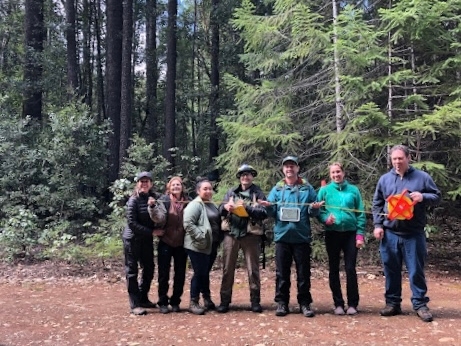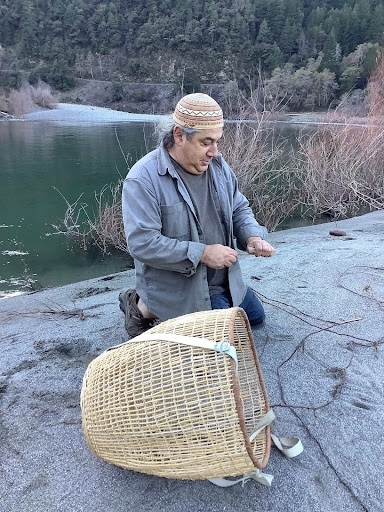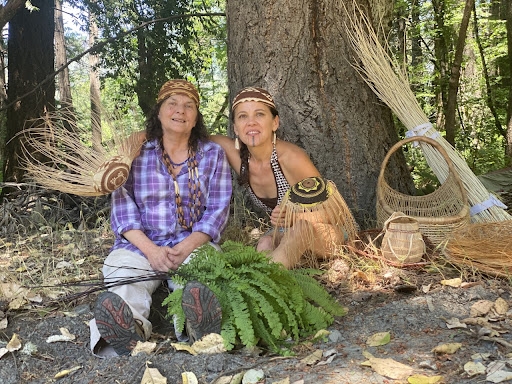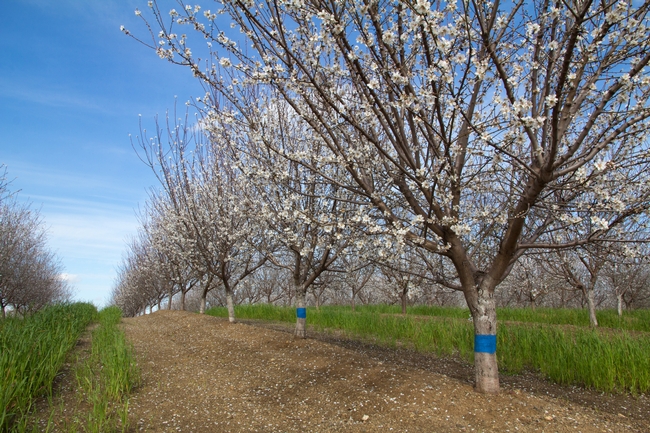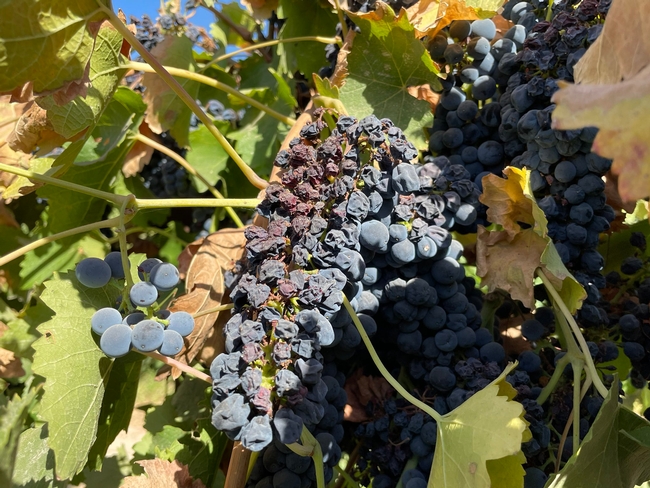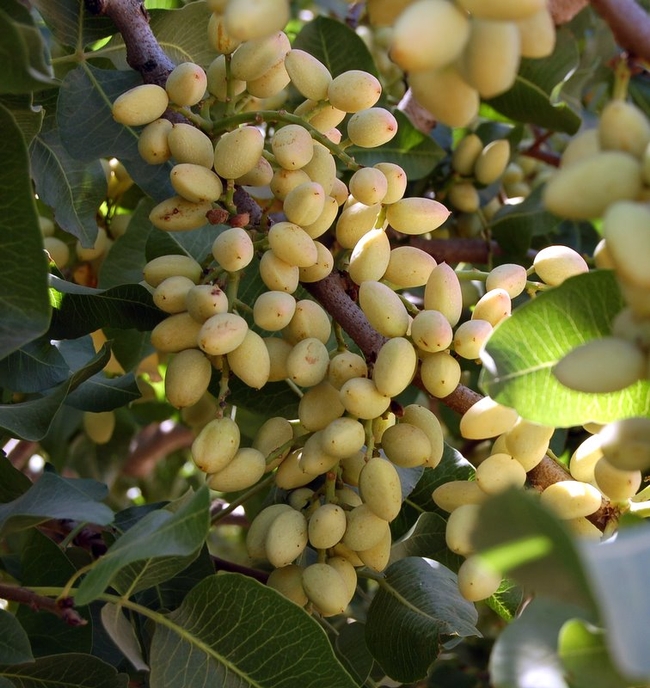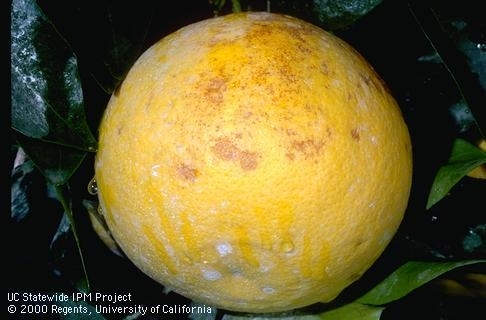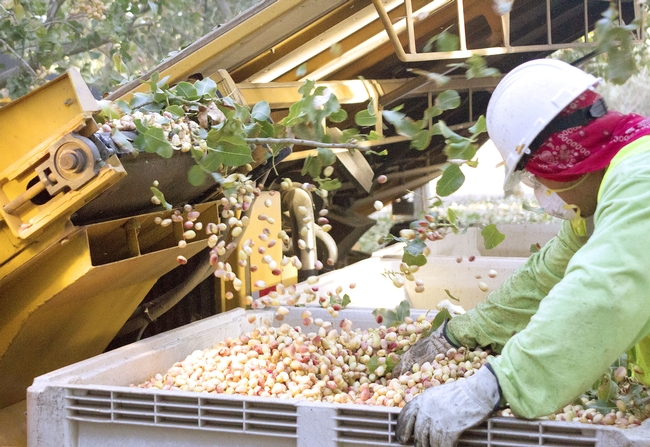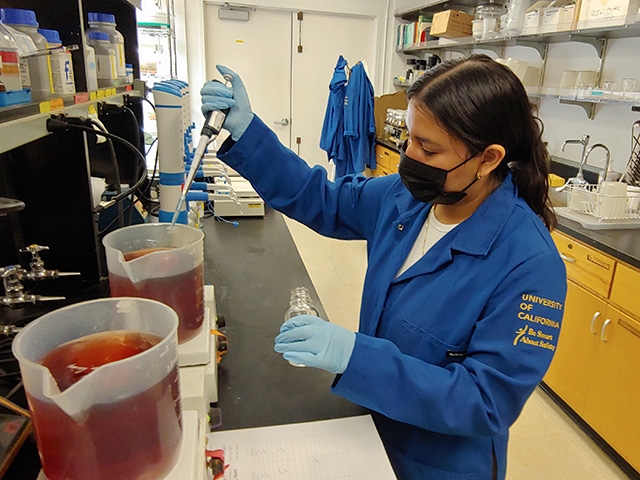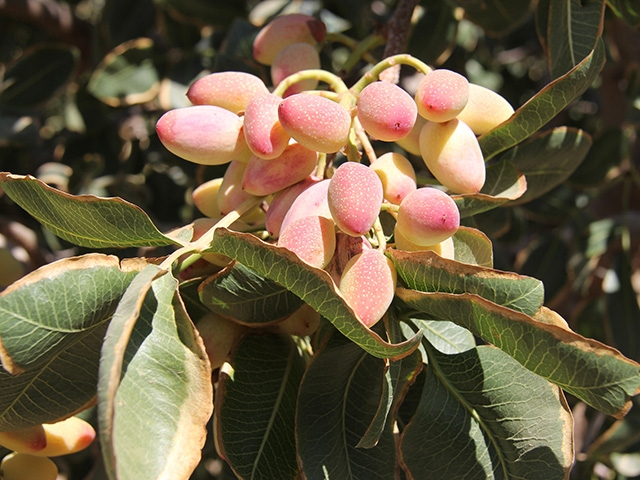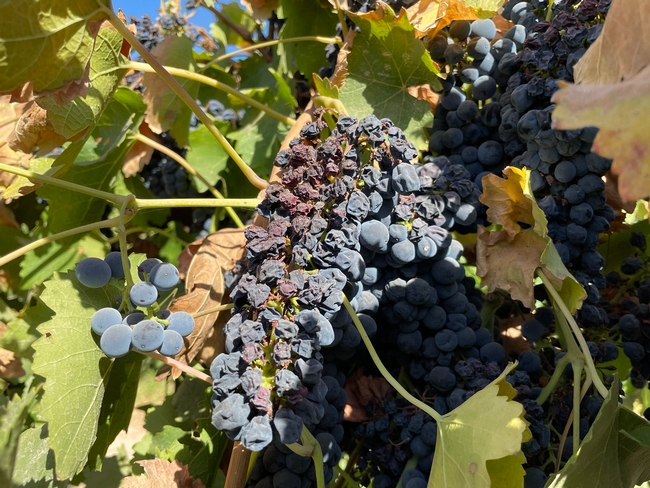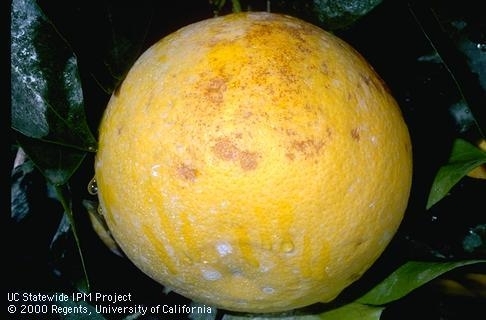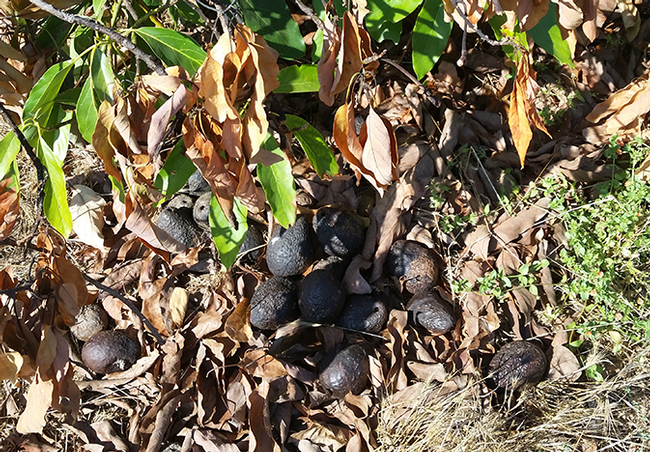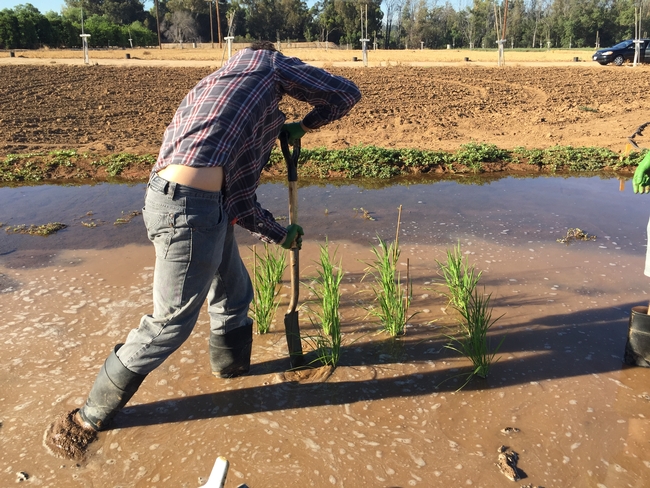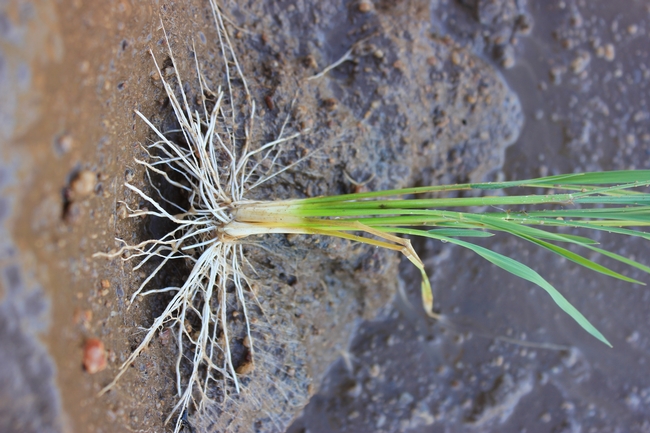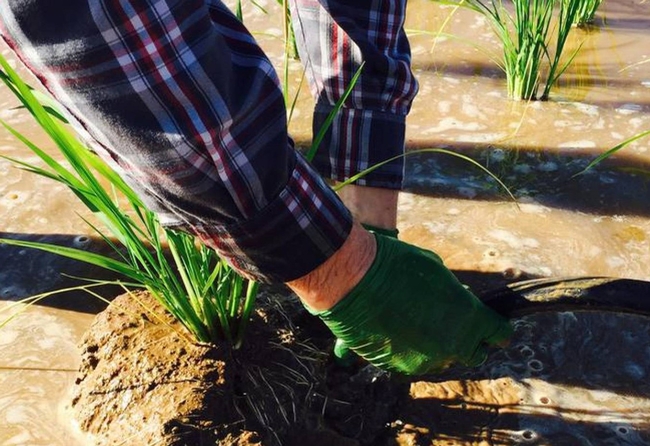Posts Tagged: climate change
Indigenous science key to adapting to climate change
UC Berkeley and Karuk Tribe use Indigenous and western science to cultivate resilient food systems under changing climate conditions.
To adapt to climate change, Karuk Tribe members identified the importance of monitoring climate stress on plant species and actively managing and restoring healthy ecosystem processes to increase the consistency and quality of their food harvests, according to a new report. The Karuk Tribe's Aboriginal Territory encompasses over a million acres in the Klamath Basin in Northern California and Southern Oregon.
The Karuk Tribe-UC Berkeley Collaborative has released findings from its four-year collaborative research in their report “Karuk Agroecosystem Resilience and Cultural Foods and Fibers Revitalization Initiative: xúus nu'éethti – we are caring for it.”
To assess climate-change impacts on cultural-use plants and their habitats and to develop strategies and tools for long-term monitoring, this project integrated Indigenous and western science perspectives.
“Understanding the breadth and intensity of climate change with regard to our cultural resources is key to developing adequate response plans,” said Karuk cultural practitioner and project co-lead Lisa Morehead-Hillman. “Without healthy stands (of trees), our cultural practices suffer. We all suffer.”
The report authors lay out specific place-based management and monitoring actions that will enhance the resilience of cultural focal species and habitats to climate change, climate variability and management threats.
To support the resilience of Indigenous cultural agroecosystems and cultural food and fiber species, as well as strengthening Indigenous food sovereignty now and into the future, the authors recommend the following management, policy, research and institutional actions:
• Supporting Karuk Tribal natural resource, data and knowledge sovereignty through appropriate engagement and Tribal oversight.
• Investing in Tribal management infrastructure and workforce development to support culturally appropriate, place-based job opportunities for Tribal members and descendants.
• Supporting co-management and family-based stewardship of cultural use plants and habitats on Karuk Aboriginal lands.
• Investing in and supporting the re-acquisition of Karuk Aboriginal lands to build back the Tribal land base and restore habitats and ecosystems.
• Funding research, monitoring, and educational opportunities that can support youth leadership development, job creation, agroecosystem resilience, and food sovereignty in Karuk Aboriginal Territory.
This research builds on the findings from a five-year Karuk Tribe-UC Berkeley Collaborative food security project (2012-2018), which found that 92% of all Tribal households in the Klamath River Basin experienced some level of food insecurity, and that having access to cultural foods was a strong predictor of food security, yet only 7% of all Tribal households had access to good quality cultural foods at all times.
“This project applies what we learned from tribal members about food insecurity and climate and land management threats to cultural foods to the landscape level, co-creating methods and tools with our Karuk colleagues to assess and restore the health, quality and abundance of cultural foods and fibers to promote food security and eco-cultural resilience,” said Jennifer Sowerwine, lead UC Berkeley collaborator and associate professor of Cooperative Extension.
Research objectives centered around the “Agroecosystem Condition Assessment,” in which UC Berkeley and Karuk researchers and cultural practitioners assessed the health, quality and yield of 20 cultural-use focal plants prioritized by the Karuk Tribe, such as tanoak acorns, evergreen huckleberry, bear grass and hazel, as well as the condition of their habitats.
“This project demonstrates the benefits of working with a diverse research partnership in the co-production of climate science using blended Indigenous and Western research and monitoring methods,” said project collaborator Frank Lake, research ecologist and USDA Forest Service Pacific Southwest tribal liaison. “This project exemplifies recent federal directives and initiatives to support tribes for climate adaptation, forest restoration and eco-cultural revitalization.”
The overall quality and condition of most of the focal species found in the research plots and patches reflect both the devastating impact of colonial land-management practices – including timber harvest, fire exclusion and mining – as well as clear evidence of climate stress such as aborted fruit, early die back and poor-quality product. Forced exclusion of cultural management is reflected in encroachment of invasive species, inappropriate canopy cover and poor-quality harvests impacting both human and animal access to these important plant resources.
“This work done among Indigenous knowledge holders and academia is paramount to developing and sustaining a well-trained workforce for the future,” said Bill Tripp, director of the Karuk Tribe Department of Natural Resources and project co-lead. “We have a long way to go in realizing cultural relevancy in addressing the systemic injustices that plague our people, accelerate climate change, and work against ecosystem process and function.”
Based on research findings informed by the deep insights of Karuk natural resources managers, Karuk elders and cultural practitioners, the report outlines recommendations for restoring key habitats and revitalizing culturally significant species to enhance agroecological resilience in Karuk Aboriginal lands, which are concurrently administered, managed and occupied by U.S. Forest Service and private landowners.
Kathy McCovey, a Karuk cultural practitioner, archaeologist, forest ecologist and project collaborator, explained the cultural significance of the project:
“Through this project, we are learning how to reconnect with place,” McCovey said. “In learning about and tending these areas, we are tending our family gardens. It's all about people in place. Working on this project, we are working to bring these places back to life. We're rediscovering their Karuk names and how those names signal traditional uses of plants in those places. That way we can reconnect with the places our families come from”.
“The whole river system is full of knowledge,” she elaborated. “It's a crucial time for the Karuk people to tend these areas and learn how to take care of them. This community has knowledge that's developed and evolved with these lands and we have a responsibility to support the plants in these areas. We had our land stolen out from under us, but we still live here, we still know how to tend and gather plants, we still have our knowledge and our ceremonies. We still have the ability to go out and gather from the land. We still know how to take care of this place. We take care of the land and it takes care of us.”
This project serves as an example of how university and federal agency researchers can partner with California tribes to lift up Indigenous knowledge, which can help all involved to better understand and develop solutions to the climate crisis and its effects on California's landscapes and biodiversity, especially on species of cultural significance to Indigenous communities.
Funding for the project was provided by a grant from the USDA NIFA Agriculture and Food Research Initiative Resilient Agroecosystems under Changing Climate Challenge Area.
Download the free report at the Karuk-Berkeley Collaborative website: https://nature.berkeley.edu/karuk-collaborative/wp-content/uploads/2023/03/Karuk-Resilience-Report_Smallest-file-size.pdf
Key climate data added to enhance grower decision-support tool
Free CalAgroClimate tool helps growers protect crops from frost and extreme heat
California farmers can see how climatic conditions that may affect agriculture are changing in their regions by using CalAgroClimate so they can make strategic changes. Nine new agriculturally important climate indicatorshave been added to the decision-support tool created by UC Cooperative Extension and U.S. Department of Agriculture scientists.
These new tools use a high-resolution climate dataset called PRISM to provide location-specific or county-aggregated long-term trends in agroclimatic indicators from 1980 to last year. These new agroclimate indicators include Frost Days, Last Spring Freeze, First Fall Freeze, Freeze-Free Season, Tropical Nights, Hot Days, Extreme Heat Days, Heatwaves and Diurnal Temperature Range (see definitions below). These indicators were derived from a study published in the journal Agronomy.
All of the new tools are free and available on CalAgroClimate for anyone to access.
“Frost-related tools such as Frost Days, Last Spring Freeze, First Fall Freeze, and Freeze-Free Season can help farmers and agricultural clientele make informed long-term choices,” said Tapan B. Pathak, UC Cooperative Extension specialist in climate adaptation in agriculture based at UC Merced, who is leading the CalAgroClimate project.
“For instance, if you are planning to invest in a frost sensitive crop in your region, these indicators can provide valuable information on whether frost risk has changed over time and whether it is less risky to make such an investment,” he said. “Wine grapes, for instance, are very sensitive to frost. Although not all frost events are damaging, understanding long-term trends in frost can help in making long-term strategic decisions such as whether to invest in frost protections.”
Another set of new agroclimatic indicators, on CalAgroClimate – Tropical Nights, Hot Days, Extreme Heat Days, Heatwaves and Diurnal Temperature Range – are based on higher maximum and minimum temperatures. Tropical Nights, for instance, calculates total number of nights when overnight temperatures exceed 68 F. More frequent tropical nights can increase crop respiration rates and can be detrimental for fruit quality and quantity, increase the risk of damage from pathogens, and potentially impact fruit set and yield.
Knowing how trends are evolving over time can assist growers in managing their crops to reduce risks. Similarly, growers can easily look at trends related to heat – hot days, extreme heat and heatwaves – on CalAgroClimate to assess their options on what they need to do to be adaptive. In the short term, growers may put up shade or for longer term, choose varieties that are more heat-tolerant.
“In recently published work, one of the farmers in the Central Valley told us, ‘When you really see so much difference in a short amount of time in your immediate area…we would have to look at that and say, well, we're going to have to adapt varieties because this is a 20- or 25-year planting and we're going to have to find crops or varieties that will adapt to that,'” Pathak said.
Another farmer told us, “Knowing what's going to happen or at least having a good idea, if you know something's going to be become or won't be viable, then obviously you're going to try to phase that out, and phase in something that's better suited.”
Pathak added, “The new agroclimatic indicators on CalAgroClimate provide a reality check on how conditions are changing in short and long-term, what it means for farmers and to assist them on deciding what they need to do to be adaptive. These tools will greatly benefit farmers and agricultural clientele in assessing risks and making informed decisions.”
Other collaborators include StevenOstoja and Lauren Parker of theUSDA California Climate Hub,PrakashKumarJha of UC Agriculture and Natural Resources and Robert Johnson and ShaneFeirer of UC Agriculture and Natural Resources' Informatics and Geographic Information Systems.
Definitions of AgroClimatic Indicators:
Frost Days are days in a year with minimum temperature below or equal to 32F.
Last Spring Freeze is the latest day in spring when minimum temperature is below or equal to 32F.
First Fall Freeze is the earliest day in fall when minimum temperature falls to 32F or below.
Freeze-Free Season is the time between the last spring and first fall freeze, represented by the number of consecutive days in a year without freezing temperatures.
Tropical Nights are number of nights when temperatures exceed 68F.
Hot Days are the days per year with maximum temperature exceeding 100 °F.
Extreme Heat Days are the number of days per year with maximum temperatures warmer than the 98th percentile of historical summer maximum temperature for the selected location.
Heatwaves are events that occur when extreme heat lasts for at least three consecutive days.
Diurnal Temperature Range is the difference between daily maximum and minimum temperatures.
NIFA funds $3.8 million project to find climate-resilient pistachio trees
Growers invited to participate in study by sharing their experiences
A multi-state team led by Patrick J. Brown has been awarded nearly $3.8 million over the next four years for a project to improve pistachio production as the industry faces warmer winters and scarcer water.
“We are at this unique point in history where we can do this,” said Brown, an associate professor in the UC Davis Department of Plant Sciences.
The project aims to ensure the industry can thrive in coming decades despite the challenges faced. Growers are invited to participate in the study, sharing what they already are trying in their own fields or supporting any aspect of the project. To discuss the possibilities, contact Brown at pjbrown@ucdavis.edu or (530) 752-4288.
The project includes research to ensure pollination, experiments to calculate irrigation needs amid water shortages, creating tools to improve public breeding programs, developing more efficient harvesting equipment, and economic analyses to ensure future pistachio cultivation is economically rewarding. Researchers hope to offer a guide for growers deciding whether to plant new orchards or remove existing ones.
“The success of California's pistachio industry, which is the top producer of the nuts in the world, has always relied on a strong collaboration between UC researchers and pistachio growers,” said project participant Florent Trouillas, a UC Cooperative Extension specialist in the UC Davis Department of Plant Pathology. “Research efforts must continue to address enduring and new challenges, improve sustainability and ensure the profitability of pistachio farming.”
The tasty, green nuts have blossomed into a $5.2-billion industry in California, thanks to their greater tolerance of dry lands and salty soils. The project aims to further improve their climate resilience by finding a rootstock that can thrive despite growing water scarcity and declining water quality projected over the next half-century. With millions of genetically distinct pistachio trees growing in the state, "we already have out there what may be the industry's next great rootstock," Brown said. "It's probably in some grower's field already. We just have to find it."
Researchers seek to pair that new rootstock with high-yielding scions – the producing part of the tree grafted onto the rootstock – to develop new combinations that can thrive in the different conditions across the state.
Trouble with “boy meets girl”
Pistachios, like many other tree crops, have male and female trees, and they require hundreds of hours of wintertime temperatures below 45 degrees Fahrenheit for the trees to flower in the spring. Wind blows the pollen from male flowers to female flowers, creating nuts.
Complicating the timing: Boy flowers and girl flowers generally require different amounts of winter cold to bloom. After a sufficiently cold winter, boys and girls flower together. But if the winter is warm, most of them will flower at different times, reducing pollination.
That happened in the winter of 2014-15, which saw unusually warm winter temperatures. The following fall, farmers harvested only half their expected crop, losing more than $1 billion, Brown said. Climate change is expected to provoke progressively warmer winters in the future, on average.
An additional complication: The boy scions come from a single variety, or cultivar, and the girl scions come from another single cultivar. "In California part of the problem is that we have been relying on a single male and single female cultivar," Brown explained.
A key part of this project will be to test new scions that can pollinate efficiently despite warmer winters. “We now have additional male and female scions released in the last 10 to 15 years, but we need more information on their chill requirements,” Brown said.
Growing importance of pistachio sector
With nearly 520,000 acres planted in California in 2021, pistachios are the fastest-growing tree nut crop in the state. Growers have doubled their plantings over the past decade, due to pistachios' drought tolerance and higher gross returns compared to other nuts, experts report. California dominates the industry, growing 99 percent of the nation's crop and nearly 60 percent of the world's crop, employing people in 47,000 full-time-equivalent jobs and creating $5.2-billion of total economic impact in 2020, according to American Pistachio Growers.
Brown's team is part of a wider effort at UC Davis to support the sector's growth and adaptation to climate change. Other department members participating in the project include co-directors Louise Ferguson, a UC Cooperative Extension pomologist, and Richard W. Michelmore, a distinguished professor and director of the UC Davis Genome Center. Also participating are Giulia Marino, a UC Cooperative Extension specialist; and Grey Monroe, an assistant professor.
Other UC Davis participants include Trouillas and Brittney Goodrich, a UC Cooperative Extension specialist in the Department of Agricultural and Resource Economics. The project also includes researchers from UC Merced, New Mexico State University and Purdue University.
The four-year project was among nearly $70 million in Specialty Crop Research Initiative grants awarded this fall by the National Institute of Food and Agriculture. The Department of Plant Sciences landed three of the 25 grants.
Read the NIFA grant summary.
New interactive web tools help growers cope with climate change
UCCE, USDA California Climate Hub launch CalAgroClimate decision-support tool
Climate and weather variability pose increasing risks to farmers. As world leaders gather in Egypt at COP27 to address the climate crisis, University of California Cooperative Extension and the USDA California Climate Hub are launching new web-based tools to provide farmers with locally relevant and crop-specific information to make production decisions that reduce risk.
“Integrating historical weather data and forecast information with meaningful agricultural decision support information holds the potential to reduce a crop's vulnerability to such risks,” said Tapan Pathak, UC Cooperative Extension climate adaptation specialist at UC Merced.
“To provide easy access to high-resolution data in the form of agroclimate tools and information, and to enhance agricultural resilience to climate and weather-related risks, we are launching CalAgroClimate,” Pathak said.
Pathak is collaborating on building the decision support tool with partners from the U.S. Department of Agriculture, California Climate Hub, UC Cooperative Extension and UC Agriculture and Natural Resources' Informatics and Geographic Information Systems or IGIS.
“CalAgroClimate has been designed to support climate-enabled decision making for those working in the California specialty crop industry,” said Steven Ostoja, Director USDA California Climate Hub. “The USDA California Climate Hub is a proud collaborator on this important initiative to ensure the state's agricultural industry can continue to thrive in a future of climate change.”
Shane Feirer and Robert Johnson of UC ANR IGIS designed the interactive tools on the website and Lauren Parker of the USDA California Climate Hub contributed to content organization.An advisory panel composed of colleagues from UCCE and the Natural Resources Conservation Service ensure CalAgroClimate tools are relevant to stakeholder needs.
“CalAgroClimate is an amazing new tool that puts comprehensive past and forecast weather data at any grower's disposal,” said Mark Battany, UC Cooperative Extension water management and biometeorology advisor for San Luis Obispo and Santa Barbara counties.
“California's high-value crops are subject to a myriad of weather-related risk factors; this tool will allow growers to better address both near-term and long-term risks, and in the end grow more profitably, said Battany, who is a member of the CalAgroClimate advisory panel.
Growers and crop consultants can use CalAgroClimate's crop and location-specific tools and resources to help make on-farm decisions, such as preparing for frost or untimely rain and taking advantage of expected favorable conditions.
CalAgroClimate currently includes heat advisory, frost advisory, crop phenology and pest advisory tools.
Heat advisory tool: Extreme heat poses a danger for people, animals and crops. With this tool, users can select location and temperature threshold (e.g. 90 F, 95 F 100 F) based on their crop-specific heat tolerance level and the tool will provide a customized map of heat risk for next seven days for that location, including the number of consecutive days with temperature above that threshold. Users can also assess overall heat risks across the state for a selected temperature threshold as well. Having an early warning about hot temperatures, growers can take steps to reduce risks associated with extreme heat such as providing shade, changing farm workers' schedules and applying additional irrigation.
Frost advisory tool: Frost risk is a very serious issue for many specialty crops across California. Similar to the heat advisory tool, this tool provides a customized map of frost advisory for next seven days for a user's location, and forecast of consecutive days with temperature falling below the selected temperature thresholds (e.g. 35 F, 32 F, 28 F). Similar to the heat advisory, early warning about cold temperatures can provide growers some time to protect their crops from frost damage.
Crop phenology tool: The scientists have developed a-crop specific and location-specific crop phenology tool to help users keep track of growing degree days accumulations and estimate critical growth stages. CalAgroClimate uses a high-resolution PRISM dataset to provide near real-time crop phenology information to users. This tool will inform growers about how their crop development compares to previous years, which can be helpful in planning activities specific to critical growth stages.
Pest advisory tool: Similar to crops, development of certain pests and diseases is controlled by temperature and heat unit accumulations. With the pest advisory tool, growers can keep track of estimated pest generations during the growing season to make pest management decisions.
“We are launching the website with this initial set of tools while working on adding more crop-specific information and several new tools in the near future, ” Pathak said. “We look forward to getting feedback from growers who use CalAgroClimate to make it even more useful.”
New strategies to save the world’s most indispensable grain
Genetic insights help rice survive drought and flood
Plants — they're just like us, with unique techniques for handling stress. To save one of the most important crops on Earth from extreme climate swings, scientists are mapping out plants' own stress-busting strategies.
A UC Riverside-led team has learned what happens to the roots of rice plants when they're confronted with two types of stressful scenarios: too much water, or too little. These observations form the basis of new protective strategies.
“This one crop is the major source of calories for upwards of 45 percent of humanity, but its harvests are in danger,” said Julia Bailey-Serres, UCR geneticist and study lead. “In the U.S., floods rival droughts in terms of damage to farmers' crops each year.”
While it is possible for rice to flourish in flooded soils, the plants yield less food or even die if the water is too deep for too long. This work simulated prolonged floods of five days or longer, in which plants were completely submerged. It also simulated drought conditions.
In particular, the researchers examined the roots' response to both types of conditions, because roots are the unseen first responders to flood and drought-related stress.
Their work is described in a new paper published in the journal Developmental Cell.
One key finding is about a cork-like substance, suberin, that's produced by rice roots in response to stress. It helps protect from floods as well as from drought.
“Suberin is a lipid molecule that helps any water drawn up by the roots make it to the shoots, and helps oxygen from shoots to reach roots,” Bailey-Serres said. “If we reinforce the plant's ability to create suberin, rice has better chances for survival in all kinds of weather.”
The researchers were able to identify a network of genes that control suberin production and can use this information for gene editing or selective breeding.
“Understanding suberin is particularly exciting because it is not susceptible to breakdown by soil microbes, so carbon that the plant puts into suberin molecules in the roots is trapped in the ground,” said Alex Borowsky, UCR computational biologist and study co-author.
The researchers also identified the genes controlling some of rice's other stress behaviors.
“One of our interesting findings is that when rice plants are submerged in water, the root cell growth cycle goes on pause, then switches back on shortly after the shoots have access to air,” Bailey-Serres said.
In the future, the research team plans to test how modifying these stress responses can make the plant more resilient to both wet and dry conditions.
“Now that we understand these responses, we have a roadmap to make targeted changes to the rice genome that will result in a more stress-tolerant plant,” Bailey-Serres said.
Though heavy rains and droughts are both increasing as threats, Bailey-Serres has hope that new genetic technology can increase its resilience before it's too late.
“With genome editing, the fact that we can make a tiny but targeted change and protect a plant from disease is amazing. Though our crops are threatened, new technologies give us reasons to hope,” Bailey-Serres said.


